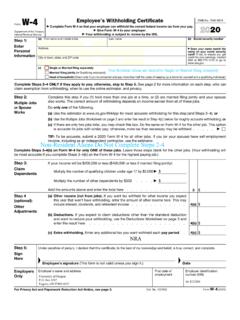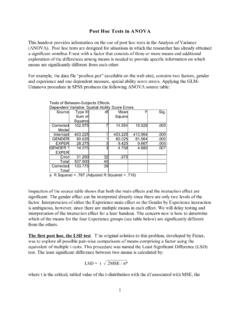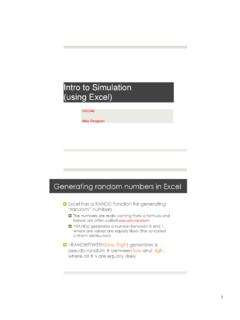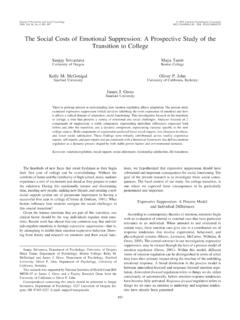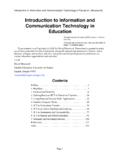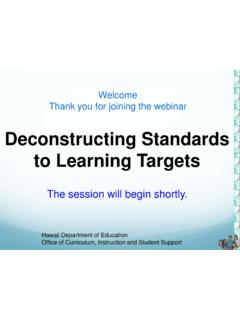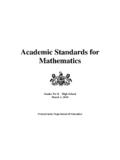Transcription of Common%Core%Math%−% …
1 Developed by Tricia Bevans and Dev Sinha of the For further information see: University of Oregon Department of Mathematics November 2014 and common core math A Grade- by- Grade View for Parents To parents - In this document we give a grade- by- grade view of the development of mathematics learning described in the common core State Standards. We suggest you first go to your child s grade level and look at those pages. At each grade K- 8, there is one page of discussion followed by one page with an example activity. At high- school, we mix the discussion and examples, but still limit ourselves with four pages for all of high- school.
2 We encourage you to take your time in reading, especially in looking at examples. Well- aligned common core materials are designed to develop or use important skills while encouraging problem solving and reasoning, which means there can be more to such materials than meet the eye at first. After looking at the pages at your child s grade level, there are a number of ways we suggest following up further for understanding (in no particular order): Look at pages about adjacent grades. Look at our discussion of the Big Picture of common core math and General Tips for Parents, at the end of this document. Look at tasks on Read some Progressions Documents, which are at We mention some other resources within this document, but because best additional resources depend on what your child s school is doing, we do not attempt to give a comprehensive list of such.
3 To teachers and administrators - These documents are designed with events such as curriculum nights or parent- teacher conferences in mind. We have kept things down to one page (front and back) at each grade level except high- school, where two pages will do. The goal is to provide parents with useful, illuminating, correct information - enough for parents to begin to see the changes brought about by the common core and the rationale for those changes, but not so much as to be overwhelming. Their brevity means these are far from comprehensive. Many important topics are not addressed at most grade levels, especially topics from geometry and from measurement and data.
4 We also have a student and classroom focus, and do not address aspects such as assessment. If you would like to provide a bit more, you may consider bundling some grades together and/or using the Big Picture and General Tips pages at the end of the document. Contents - Grade- by- grade discussions, from Kindergarten (pages 3- 4) and First Grade (5- 6) through Eighth Grade (19- 20) and High- School (21- 24). These are followed by a discussion of the Big Picture of common core math and General Tips of Parents (pages 25- 26). Developed by Tricia Bevans and Dev Sinha of the For further information see: University of Oregon Department of Mathematics November 2014 and This page is here mainly so that the document when printed double- sided has a single grade on each page, front and back.
5 But while we re here we might as well recall the all- important Standards for Mathematical Practice, organized together by broader themes. The short version of the story of the common core is that we want to see all students engage in these practices throughout their learning of mathematics, Developed by Tricia Bevans and Dev Sinha of the For further information see: University of Oregon Department of Mathematics November 2014 and common core math in Kindergarten The main focus in kindergarten is a solid understanding of numbers up to twenty. Of course children will work on counting as part of this.
6 One aspect that will be new for some classrooms is counting starting from numbers other than one. This helps with addition and subtraction. Kindergarteners will compare groups of things to decide which is bigger. They will combine groups together or take some away from a group. Eventually they'll use written numbers to describe what's happening. Kindergarteners will usually have rug time discussion of math as well as play games. A change (for some) is that all of this investigation is carefully directed to develop skills important for later grades. One of the most important skills in math that students begin in kindergarten is putting things together and taking them apart in various ways.
7 They'll think about different ways that a number can be made from two other numbers as they begin to think about addition and subtraction. The geometry kindergarteners learn reinforces this idea of putting together and taking apart, too. For example, students may be asked to make two triangles by breaking apart a square or to put together shapes to form a new one. Examples: The ideas in My Book of Five (see reverse) help children understand what it means to add and subtract. This will help prepare kindergarteners to add and subtract fluently within 5. An important application of this idea later comes in representing the teen numbers as ten and some more ones (so that 13 means 10 and 3 more ones) because it is the foundation for regrouping/ exchanging (what most of us learned as borrowing and carrying ).
8 Recognizing the various combinations of numbers that make up the numbers from 1 to 10 is a critical building block in learning multi- digit arithmetic. Tips for parents: Count with them as much as possible! Practice counting starting at different numbers. For example ask your child what number comes after seven and then begin counting from there. This will help them with addition and subtraction. Play games that encourage breaking apart numbers in different ways. Also, point out how a group of objects can also be broken down into smaller groups. For example, you could see that a group of five plates contains four big plates and one little plate.
9 For teen numbers, you may even count in the unit- form way that emphasizes the ten ( eight, nine, ten, ten- and- one, ten- and- two, ten- and- three, ..) as well as with standard names. This will help build understanding of place value, which is the key to knowing how numbers work. Developed by Tricia Bevans and Dev Sinha of the For further information see: University of Oregon Department of Mathematics November 2014 and Example: My book of five Materials: Double sided counters Markers that are the same colors as the counters Teacher- made My Book of 5 (see below for detailed directions) Action: Students will be given double sided counters/dots (see picture of counters at right).
10 It is important for the markers to match the colors on the counters. Students take five counters in their cupped hands (or a cup), shake them around, and pour them onto the desk. Next, they count how many counters are yellow and how many are red. Students then record the numbers in their book and write a corresponding equation. For example, if the counters landed so that 1 was yellow and 4 were red, then the student would draw one yellow dot and four red dots and then write 1+4=5 under the drawing. The student would then collect the counters and roll them again. For each combination of colors, the students record with a picture and an equation.
